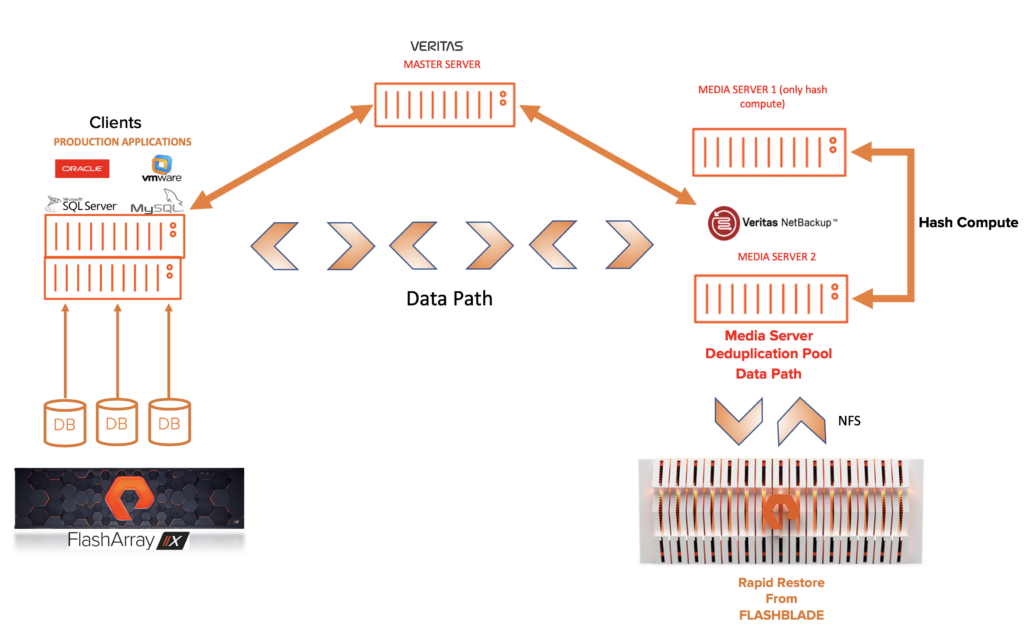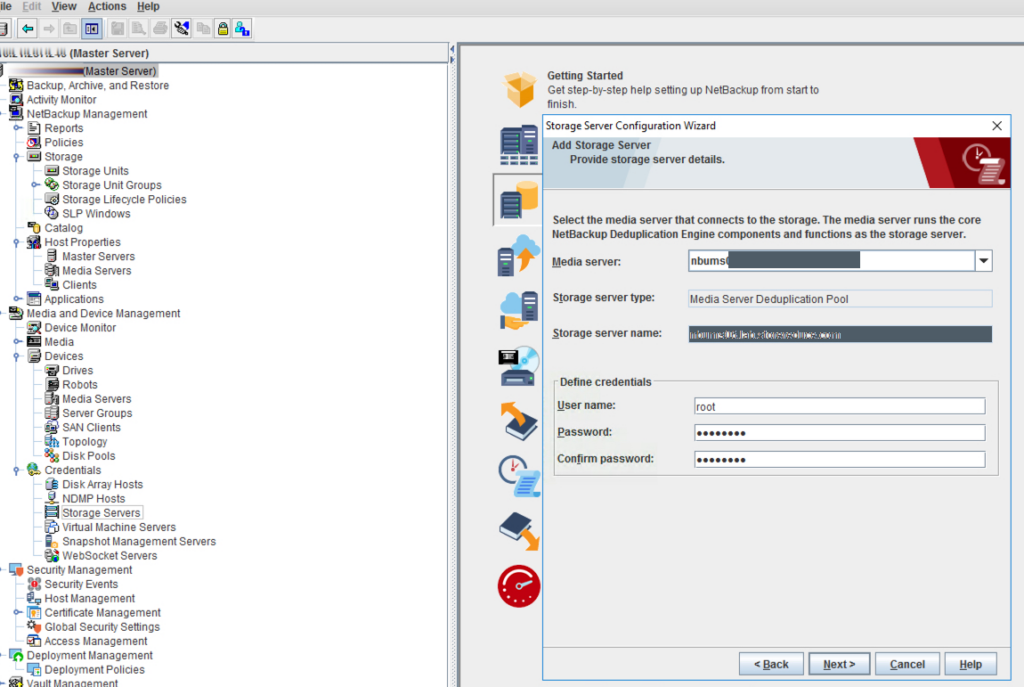Many of us must be wondering how does the NetBackup MSDP work with FlashBlade? How to configure NetBackup MSDP on FlashBlade NFS? What are the benefits of having FlashBlade as a Storage target? this blog and my other blogs will help answer many of your questions.
Recently NetBackup and Pure worked closely to support MSDP over NFS on FlashBlade with direct availability from Veritas, and this blog will help know about the implementation of the Solutions for both existing NetBackup users and new users.
NetBackup MSDP (Media Server Deduplication)
Veritas NetBackup provides the deduplication options that let you deduplicate data everywhere, as close to the source of data as you require. MSDP provides the following benefits:
- Reduce the amount of data that is stored.
- Reduce backup bandwidth.
- Reduce backup windows.
- Reduce infrastructure.
MSDP lets you choose at which point in the backup process to perform deduplication. NetBackup can manage your deduplication wherever you implement it in the backup stream. With media server deduplication, the NetBackup client software creates the image of backed up files as for a normal backup. The client sends the backup image to a media server, which hosts the plug-in that duplicates the backup data. The media server can be the storage server or a load balancing server if one is configured. The deduplication plug-in breaks the backup image into segments and compares the segments to all of the segments that are stored in that deduplication node. The plug-in then sends only the unique segments to the NetBackup Deduplication Engine on the storage server. The Deduplication Engine writes the data to a Media Server Deduplication Pool.
A storage server is an entity that writes to and reads from the storage. One host functions as the storage server, and only one storage server exists for each NetBackup deduplication node. The host must be a NetBackup media server. Although the storage server components run on a media server, the storage server is a separate logical entity.
Reference Architecture
For fast backup and fast restore, the primary application for backup should be hosted on an all-flash array-like Pure Storage FlashArray™. Then FlashBlade acts as an NFS storage target for backups conducted by NetBackup. The test architecture for Veritas NetBackup with Pure Storage arrays is illustrated in the Figure below.

NetBackup can use FlashBlade as a target for deduplicated or non-deduplicated backups. The maximum size of the media server deduplication pool (MSDP) size on a FlashBlade is limited. NetBackup features such as client-side and server deduplication, Accelerator, and Auto Image Replication (AIR) are supported with this integration, however, instant access and universal shares are not supported.
FlashBlade As NFS Target
Configuration of FlashBlade as an NFS target for NetBackup involves creating data volume(s), an MSDP metadata volume, a NetBackup catalog volume, and exporting these volume(s) as an NFS share to the host acting as a media server. These shares are then mounted on the media server and configured as one MSDP storage pool and to be a target storage unit for data backup and catalog backup. Implementing multiple volumes allows for additional parallelism and paths to FlashBlade. please refer to my other blog on how to set up the NFS export from FlashBlade and mount this NFS on Media server on FlashBlade.
How to Configure NetBackup MSDP on FlashBlade NFS
- Create, NFS filesystems on FlashBlade (recommended is 8 Filesystems for Data backup and one Filesystem for MSDP Metadata
- Create the appropriate Mount points directories on the Media Server one for each NFS data filesystem(8) and one for MSDP filesystem.
- Mount all the NFS on the Media server while using different Data VIPs on FlashBlade.for example NFS FS1 is mounted on directory /msdp/vol1, NFS FS2 on /msdp/vol2 and so on until each volume is mounted, along with NFS for metadata on /msdp/metdata-vol
- Create a touch a file /etc/nbapp-release if it doesn’t exist.
- Create a sub-directory – ‘data’ under each mounted volume ex: /msdp/vol1/data, /msdp/vol2/data, /msdp/vol3/data, and so on.
- Configure the MSDP through the Storage Server Configuration Wizard. Ensure that the Use alternate path for deduplication database option is checked
To create and configure Media Server Deduplication Pool via GUI and using Wizard, please follow steps:
I. Start the NetBackup administration console and click Configure Disk Storage Servers., Select Media Server Deduplication Pool. Click Next

II. Choose media server, type user name and password. Click Next, and it is not recommended to select NetBackup Master Server.

III. Select storage path and also deduplication database path, to have a better performance it is recommended to have the MSDP metadata on separate FlashBlade NFS mount point and Click Next.

IV. Make sure to not to select NetBackup Encryption option, since FlashBlade has it’s own Encryption enabled by default.

V. Review the storage server configuration summary. Click Next.

VI. Please wait while the wizard finishes completing the storage server. Then click Next to start the wizard to create a disk pool.

7.
7. Add additional data NFS filesystem mounted on Media Server into the MSDP storage pool by using the following command. /usr/openv/pdde/pdcr/bin/crcontrol –dsaddpartition /msdp/vol2/data
/usr/openv/pdde/pdcr/bin/crcontrol –dsaddpartition /msdp/vol3/data
…. and so on through vol8…
The MSDP configuration is now complete. To verify that the deduplication pool contains the new volumes, review the following command: /usr/openv/pdde/pdcr/bin/crcontrol –dsstat 2
/usr/openv/pdde/pdcr/bin/crcontrol --dsstat 2
Best Practices
Provisioning NFS FS For Deduplicated Data
When FlashBlade is used as an NFS storage target for deduplicated data, performance increases when employing multiple volumes exported to multiple shares with different data virtual IP addresses and combined to be one media server deduplication pool (MSDP) on a single media server. Implementing multiple volumes allows for additional parallelism and paths to FlashBlade. As a best practice, the minimum volume size that should be created on FB NFS for MSDP should be at a minimum of 10 TB when utilizing multiple volumes in a single MSDP. Also, the number of filesystems per MSDP should be limited to no more than eight, this is the limitation with NetBackup MSDP.
For now, this integration is only supported for limited backend storage capacity (after dedupe) for further information on the capacity please contact Pure Sales.
TakeAway
For customers seeking an efficient storage solution that provides “rapid restore” of their environment, FlashBlade as an NFS storage target for NetBackup deduplicated data is great. Sending NetBackup deduplicated data to FlashBlade over NFS is an exclusive integration.
- Achieve superior rapid restore performance with FlashBlade and support multiple, concurrent backup and restore operations that take advantage of FlashBlade as a storage platform for NetBackup.
- Gain support for key NetBackup features such as client-side and server deduplication, Accelerator and AIR.
- Improve storage efficiency when utilizing both NetBackup and FlashBlade compression.
To learn more about this solution, read this whitepaper.